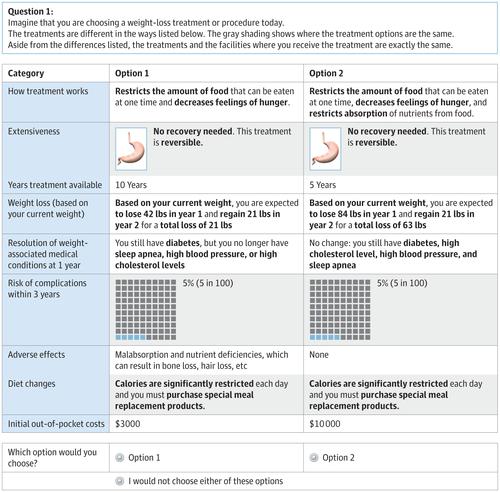JAMA Surgery ( IF 15.7 ) Pub Date : 2019-01-01 , DOI: 10.1001/jamasurg.2018.4375 Michael D. Rozier 1 , Amir A. Ghaferi 2, 3 , Angela Rose 4 , Norma-Jean Simon 5 , Nancy Birkmeyer 6 , Lisa A. Prosser 7, 8

|
Importance Surgical options for weight loss vary considerably in risks and benefits, but the relative importance of procedure-associated characteristics in patient decision making is largely unknown.
Objective To identify patient preferences for risks, benefits, and other attributes of treatment options available to individuals who are candidates for bariatric surgery.
Design, Setting, and Participants This discrete choice experiment of weight loss procedures was performed as an internet-based survey administered to patients recruited from bariatric surgery information sessions in the State of Michigan. Each procedure was described by the following set of attributes: (1) treatment method, (2) recovery and reversibility, (3) time that treatment has been available, (4) expected weight loss, (5) effect on other medical conditions, (6) risk of complication, (7) adverse effects, (8) changes to diet, and (9) out-of-pocket costs. Participants chose between surgical profiles by comparing attributes. Survey data were collected from May 1, 2015, through January 30, 2016, and analyzed from February 1 to June 30, 2016.
Main Outcomes and Measures Estimated relative value of risks and benefits for leading weight-loss surgical options and marginal willingness to pay for procedure attributes. A latent class analysis identified respondent subgroups.
Results Among the 815 respondents (79.9% women; mean [SD] age, 44.5 [12.0] years), profiles of hypothetical procedures that included resolution of medical conditions (coefficient for full resolution, 0.229 [95% CI, 0.177 to 0.280; P < .001]; coefficient for no resolution, −0.207 [95% CI, −0.254 to −0.159; P < .001]), higher total weight loss (coefficient for each additional 20% loss, 0.185 [95% CI, 0.166 to 0.205; P < .001]), and lower out-of-pocket costs (coefficient for each additional $1000, −0.034 [95% CI, −0.042 to −0.025; P < .001]) were most likely to be selected. Younger respondents were more likely than older respondents to choose treatments with higher weight loss (coefficient for loss of 80% excess weight 0.543 [95% CI, 0.435-0.651] vs 0.397 [95% CI, 0.315-0.482]) and were more sensitive to out-of-pocket costs (coefficient for $100 out-of-pocket costs, 0.346 [95% CI, 0.221-0.470] vs 0.262 [95% CI, 0.174 to 0.350]; coefficient for $15 000 in out-of-pocket costs, −0.768 [95% CI, −0.938 to −0.598] vs −0.384 [95% CI, −0.500 to −0.268]). Marginal willingness to pay indicated respondents would pay $5470 for losing each additional 20% of excess body weight and $12 843 for resolution of existing medical conditions, the most desired procedure attributes. Latent class analysis identified the following 3 unobserved subgroups: cost-sensitive (most concerned with costs); benefit-focused (most concerned with excess weight loss and resolution of medical conditions); and procedure-focused (most concerned with how the treatment itself worked, including recovery and reversibility).
Conclusions and Relevance Candidates for bariatric surgery identified costs, expected weight loss, and resolution of medical conditions as the most important characteristics of weight loss surgery decisions. Other information, such as risk of complications and adverse effects, were important to patients but less so.
中文翻译:

减肥手术的患者偏好:使用离散选择实验方法的调查结果
重要性 减肥的手术选择在风险和收益方面差异很大,但是与手术相关的特征在患者决策中的相对重要性在很大程度上尚不清楚。
目的 确定患者对减肥手术的风险,收益和治疗选择的其他属性的偏好,这些患者可用于减肥手术。
设计,设置和参与者 这项减肥程序的离散选择实验是作为一项基于互联网的调查而进行的,该调查是对密歇根州减肥手术信息会议招募的患者进行的。每个程序均由以下属性集描述:(1)治疗方法,(2)恢复和可逆性,(3)治疗可用的时间,(4)预期的体重减轻,(5)对其他医学状况的影响, (6)发生并发症的风险,(7)不良影响,(8)改变饮食习惯和(9)自付费用。参与者通过比较属性来选择不同的手术方式。调查数据收集自2015年5月1日至2016年1月30日,并于2016年2月1日至6月30日进行了分析。
主要成果和措施 领先的减肥手术选择的风险和收益的相对价值以及对手术属性的边际支付意愿的估计值。潜在类别分析确定了应答者亚组。
结果 在815名受访者中(79.9%的女性;平均[SD]年龄为44.5 [12.0]岁),假设程序的特征包括对医疗条件的解决(完全解决的系数为0.229 [95%CI,0.177至0.280;P] <.001];无分辨率的系数为-0.207 [95%CI,-0.254至-0.159;P <.001]),总重量损失较高(每增加20%的损失系数为0.185 [95%CI,0.166]到0.205;P <.001]),并降低自付费用(每增加$ 1000的系数,-0.034 [95%CI,-0.042到-0.025;P<.001])。年轻的受访者比年长的受访者更有可能选择体重减轻更高的治疗方法(体重减轻80%的体重系数0.543 [95%CI,0.435-0.651] vs 0.397 [95%CI,0.315-0.482]),并且更敏感自付费用(自付费用100美元的系数为0.346 [95%CI,0.221-0.470]与0.262 [95%CI,0.174至0.350];自付费用为15000美元的系数成本,-0.768 [95%CI,-0.938至-0.598]与-0.384 [95%CI,-0.500至-0.268])。边际支付意愿表明,受访者将为每增加20%的超重体重损失支付5470美元,并为解决现有医疗状况(最需要的程序属性)支付12843美元。潜在类别分析确定了以下3个未观察到的子组:成本敏感型(最关注成本);以利益为中心(最关注过度减肥和医疗状况的解决);以过程为中心(最关心治疗本身的工作方式,包括恢复和可逆性)。
结论和相关性 减肥手术的候选人将成本,预期的体重减轻和医疗状况的解决确定为减肥手术决策的最重要特征。其他信息,例如并发症的风险和不良反应,对患者很重要,但重要性不高。











































 京公网安备 11010802027423号
京公网安备 11010802027423号